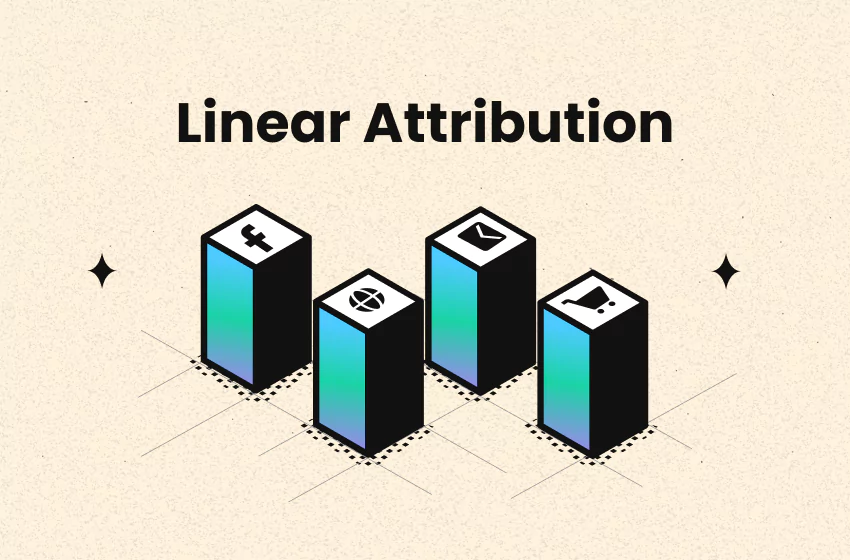W Shaped Attribution Model: All The What, Why & How
You know how challenging it is to measure the effectiveness of marketing campaigns: there are too many channels, touchpoints, and customer journeys that influence sales. So how to know which are most valuable and deserve more budget and attention?
One way to answer this question is to use the W shaped attribution model. This unique approach to tracking customer interactions can provide invaluable insights into the effectiveness of your marketing strategies.
This blog article will demystify the W shaped attribution model and explain why it is a game-changer for eCommerce. By implementing this method, you can make data-driven decisions that lead to higher conversion rates and increased profitability.
Let's start!
What Is The W Shaped Multi-touch Attribution Model?
W shaped attribution model is a marketing analytics approach that assigns credit to each touchpoint in a customer’s journey. It considers both the short-term and long-term effects of each touchpoint, giving you a more comprehensive understanding of how your marketing campaigns are performing.


The model gets its name from the way it gives more credit to three key touchpoints that form a W shape when plotted on a graph. These touchpoints are:
- The first touch: This initial interaction between a customer and your brand, whether through clicking on an ad, visiting your website, or subscribing to your newsletter, is significant as it generates awareness and interest in your products or services.
- The lead conversion: This pivotal touchpoint involves converting a prospect into a lead by filling out a form, downloading an eBook, or requesting a demo. It holds importance as it demonstrates the customer's intent and engagement.
- The opportunity creation: This touchpoint marks the conversion of a lead into an opportunity through actions like requesting a quote, adding items to the cart, or starting a free trial. It signifies the customer's readiness and willingness to make a purchase.
W shaped attribution model will give 30% of the credit to each of these three touchpoints and distribute the remaining 10% equally among all other touchpoints.
For example, if a customer interacts with:
- A Google Shopping ad (first touch)
- A blog post on your website
- A webinar registration (lead conversion)
- An email newsletter
- A coupon code (opportunity creation)
- Conversion
Then according to W shaped attribution model, the Google Shopping ad, webinar registration, and coupon code would each get 30% of the credit. Meanwhile, the blog post and email newsletter would share the last 10%, which results in 5% for each.
So why should you use W shaped attribution model? Our answer would be because this model has some certain strong points, such as:
- It recognizes the importance of multiple touchpoints in influencing customer decisions, rather than giving all the credit to one touchpoint (like in first touch or last touch attribution) or splitting the credit equally among all touchpoints (like in the linear model).
- It highlights the key moments in the customer journey that generate leads and opportunities, which are crucial for eCommerce sales.
- It helps you identify which marketing channels are most effective at attracting, engaging, and converting customers, so you can allocate your resources accordingly.
- It provides a more accurate and holistic view of your marketing ROI than other models.
W Shaped Attribution Model vs. U Shaped Attribution Model
While having various benefits, W shaped attribution model is not the only multi-touch attribution model that exists.
1. What is U shaped attribution model?
Another popular model is the U shaped attribution model, also known as position-based. U shaped attribution model gives more credit to the first and last touchpoints in the customer journey and shares the rest of the credit across the touchpoints in the middle – creating a U shape.
In Google Analytics, for example, the first and last touchpoints get 40% of the credit each, and the remaining 20% is shared among the rest of the touchpoints.
2. Differences between W shaped & U shaped attribution models
When comparing W shaped and U shaped attribution models, it becomes evident that they diverge in their credit distribution.
The W shaped model places greater importance on the mid-funnel touchpoint responsible for creating an opportunity, while the U shaped model assigns more significance to the final touchpoint that results in a sale.
The choice between these two models depends on your business goals and preferences. Some factors to consider are:
- The length and complexity of your sales cycle:
If your sales process is lengthy and intricate, involving various stakeholders and decision-makers, consider employing the W shaped model to emphasize the importance of opportunity creation.
Conversely, if your sales cycle is brief and straightforward, with fewer steps and interactions, the U shaped model may be more suitable to prioritize the final conversion stage.
- The type and quality of your leads:
If you find yourself with a large number of leads that require qualification and nurturing before they can become opportunities, the W shaped model can be utilized to give importance to the lead creation stage.
However, if you have a small number of leads that are already qualified and prepared to make a purchase, the U shaped model can be employed to emphasize the first touch stage.
- The alignment and collaboration between your marketing and sales teams:
When your marketing and sales teams are strongly aligned and collaborate effectively, the W shaped model can represent their combined efforts in the sales process.
On the other hand, if these teams lack alignment and collaboration, the U shaped model can be used to depict their individual roles and responsibilities.
How To Use The W Shaped Attribution Model to Optimize Your eCommerce Marketing Campaigns?
Now that you know what the W shaped attribution model is and how it compares to the U shaped model, let’s see how to apply it to optimize your marketing campaigns.
Here are 4 steps to follow:
Step #1: Identify your key marketing channels
The first step is to identify your key marketing channels. These are the channels that you use to reach your target audience and generate leads and sales.
Some examples of common marketing channels include:
- Paid ads (such as Google Ads, Facebook Ads, TikTok Ads, etc.) (most frequent)
- Organic search (such as SEO, content marketing, etc.)
- Social media (such as Facebook, Instagram, Twitter, etc.)
- Email marketing (such as newsletters, promotions, etc.)
- Webinars (such as live or recorded sessions, etc.)
- Referrals (such as word-of-mouth, reviews, etc.)
Before doubling down on any strategy, run the numbers through a profit margin calculator to understand which channels are delivering the best return.
Step #2: Collect data on your customer journeys
Once you have identified your key marketing channels, you need to collect data on your customer journeys. This data will show how customers interact with your marketing campaigns and move through your sales funnel.
You need to map out all the touchpoints that your customers encounter along the way, such as:
- Visiting your website
- Reading your blog posts
- Downloading your eBooks
- Registering for your webinars
- Signing up for your newsletters
- Requesting a demo
- Adding items to the cart
- Applying a coupon code
- Completing a purchase
All these data can be retrieved using tools like Google Analytics, Facebook Insights, TikTok Analytics, CRM software, or TrueProfit’s Parameter Generator.
Step #3: Use a W shaped attribution model calculator
The third step is to utilize a W shaped attribution model calculator to allocate credit to every touchpoint within your customer journeys.
This calculation can be performed manually in simple cases: you may either input the number of touchpoints and corresponding revenue into a spreadsheet or write Python code. Once you have collected all the data, use W shaped attribution model to assign credit to each touchpoint and begin your calculation.
Alternatively, if you prefer a more convenient and real-time tracking option, or if your network tracking of touchpoints is complex, consider using tools such as TrueProfit's Parameter Generator Extension for Chrome. With this handy tool from TrueProfit, you can easily apply the W shaped attribution model to your data and let it calculate credit for each touchpoint automatically.
Step #4: Analyze your results and make adjustments to your campaigns
Once you have completed your analysis of the results, it is important to use the insights gained from the W shaped attribution model to make any necessary adjustments to your campaigns.
Some questions you can answer with W shaped attribution model:
- Which marketing channels are most effective at generating leads and opportunities?
- Which marketing channels are most effective at closing sales?
- Which marketing channels are underperforming or overperforming?
- How do different marketing channels work together to influence customer decisions?
- How can you optimize your marketing budget and resources across different channels?
These answers allow you to make data-driven decisions to improve your eCommerce marketing campaigns. For example, you may want to:
- Focus on investing in channels that bring in high-quality leads and opportunities
- Experiment with various strategies and tactics for channels that drive sales
- Consider reducing or removing channels that have low ROI or negative effects
- Ensure coordination and alignment among your channels to provide a consistent and smooth customer experience
- Regularly monitor and measure your results, making necessary adjustments along the way
What Is An Example of W Shaped Attribution?
To give you a practical example of how the W shaped attribution model works, let's imagine you're an eCommerce seller specializing in organic skincare products.
Now, let's meet Jane, one of your potential customers. She's searching for a new moisturizer to help with her dry skin.
Jane hops online and searches for the best organic moisturizer on Google. She spots one of your Google Shopping ads showcasing your product with top ratings and a great price. Intrigued, she clicks on the ad and is taken to your product page. This is her first interaction with your brand.
She likes what she sees on your product page, but wants to know more about your brand and products. So, she starts browsing your website and reading some of your blog posts about organic skincare tips and benefits. This is her second encounter.
A few days later, she gets an email from you inviting her to join a live webinar where you'll share even more tips and tricks on naturally caring for the skin. She's interested and has decided to register for the webinar. This is now her third interaction, and it's also the moment when she transitions from being a potential customer to an actual lead.
On the day of the webinar, she attends the session and gets to witness a live demonstration of how to use your moisturizer and other products. The quality and effectiveness of your products impress her, so she decides it's time to give them a try. She clicks on the link in the webinar that takes her to a special landing page where she can snag a 10% discount on her first purchase. And just like that, this becomes her fourth experience with your brand.
After adding moisturizer and other products to her cart, Jane was a bit hesitant about making the payment due to the price. A pop-up offers a coupon code if she checks out in the next 15 minutes. Recognizing this as an amazing offer, she eagerly enters the code. At this point, she has already engaged with your brand five times, but this interaction marks the turning point from mere curiosity to genuine interest in what you have to offer.
With everything in order, she completes her purchase and receives an email confirmation.
If you use the W shaped attribution model to measure the impact of each touchpoint in Jane’s journey, you will get the following results:
- The Google Shopping ad (first touch) gets 30% of the credit
- The newsletter subscription (lead creation) gets 30% of the credit
- The coupon code (opportunity creation) gets 30% of the credit.
- The blog posts and the webinar registration get 5% of the credit each
This means that you can attribute 30% of Jane’s revenue to each of these three key touchpoints: the Google Shopping ad, the newsletter subscription, and the coupon code.
You can also attribute 3.33% of Jane’s revenue to each of these three other touchpoints: the blog posts, the webinar registration, and the purchase confirmation.
Tracy is a senior content executive at TrueProfit – specializing in helping eCommerce businesses scale profitably through content. She has over 4 years of experience in eCommerce and digital marketing editorial writing. She develops high-impact content that helps thousands of Shopify merchants make data-driven, profit-focused decisions.






![Time Decay Attribution Model: What It Is, Pros & Cons [2025]](https://be.trueprofit.io/uploads/time-decay-attribution-68931b1ee8064.webp)

![Ultimate Guide To U Shaped Attribution Model [+Example]](https://be.trueprofit.io/uploads/U-Shaped-Attribution-Model.png)
![The Ultimate Guide To Cross Channel Attribution [2024]](https://be.trueprofit.io/uploads/shopify-cost-of-goods-sold-definition-formula-how-to-track-2-68931b1aad5fb.webp)


![Data-Driven Attribution Model: How It Works & How to Set It Up [2025]](https://be.trueprofit.io/uploads/Data-Driven-Attribution_-Leveraging-Analytics-for-Better-Marketing-Decisions.png)
 Shopify profits
Shopify profits



